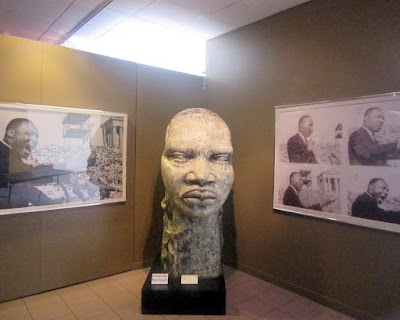DuSable Museum
of African-American History
Chicago
Visited Sept. 26, 2015
dusablemuseum.org
On Saturday, September 26, the Smithsonian held its annual Museum Day, on which the Smithsonian magazine provides (or at least facilitates) free admission to hundreds of participating museums nationwide.
I opted to visit, for the first time, the DuSable Museum of African-American History, and was happy to have my mom accompany me on the trek from Skokie to Hyde Park.
The museum, housed since 1973 in a Daniel Burnham building originally created for the Chicago Park District, is on the eastern edge of Washington Park, just west of the University of Chicago campus and medical center.
 Coincidentally, last weekend the DuSable was hosting a stage work called Anne and Emmett--about two young victims of hate, Anne Frank and Emmett Till--that was co-presented by the Illinois Holocaust Museum & Education Center, which is located in Skokie.
Coincidentally, last weekend the DuSable was hosting a stage work called Anne and Emmett--about two young victims of hate, Anne Frank and Emmett Till--that was co-presented by the Illinois Holocaust Museum & Education Center, which is located in Skokie.Mom and I probably could have caught a performance had we planned for it, but wanted to devote proper time to see the museum itself. (We also skipped the Hyde Park Jazz Fest happening nearby.)
I believe we saw all the exhibits on display, which seem to be either permanent or otherwise long-term; a new temporary exhibit was being installed in one closed gallery.
Even the museum's entrance foyer was engaging, with beautiful tile mosaics of its namesake Jean-Baptiste DuSable--who essentially founded Chicago--and other notable African-Americans, including museum founder Margaret Burroughs.
On the upper level are exhibits on Africa, African-Americans in the U.S. Military and Chicago's first black mayor, Harold Washington. There is also a room showcasing an addition to the museum being developed in another Burnham-designed structure across the street, and a striking sculpture of Dr. Martin Luther King Jr. accompanied by large photos of him speaking at Soldier Field.
The Harold Washington exhibit was especially cool, with an animatronic Mayor speaking to visitors within a reproduction of his City Hall office.
Downstairs there is some fine artwork created by Margaret Burroughs and the museum's new permanent exhibit, Freedom, Resistance and the Journey Toward Equality.
Beginning with displays about slavery--and the mass kidnappings of Africans that facilitated it--the exhibit broaches Jim Crow laws, the Civil Rights Movement, Dr. King, The Black Panthers, President Obama and more, chronicling struggle, perseverance and pride.
There are a number of rather evocative artifacts--many shown in photos here--including slave shackles, a yoke, segregated water fountains, a chair representing lunch-counter sit-ins, a jacket belonging to Fred Hampton, the bullet-riddled door of the Black Panthers' Chicago headquarters and even a KKK uniform.
Much was informative, enlightening, moving and infuriating, and I noted some aspects I should explore further, including learning more about the mutinied Amistad slave ship (I've never even seen the Spielberg movie) and looking for a documentary on the Black Panthers.
Interspersed interactive videos on a variety of topics were valuable, but viewing would be more opportune if small seating areas were provided at each video station.
And though nothing that filled the allotted space wasn't worthwhile, even in acknowledging spatial and budgetary considerations I wished more depth could be provided on various subjects.
The Great Migration is only covered on one text panel, and considerably more information on the Civil Rights Era could be beneficial, with sections on MLK and Malcolm X surprisingly sparse. There is also almost nothing included on African-American culture and community; I think a section or two on the rise of jazz, ragtime, blues, hip-hop, etc., and how entertainers helped abet and resistance, could fit well within the framework of the exhibit while likely fostering enhanced engagement.
Perhaps once the expansion is completed in the nearby Roundhouse, even more illumination could be provided by this fine and important museum. As it was, I valued my visit and believe most others would too.
And even though Museum Day 2015 has now come and gone, the DuSable Museum generously offers Free Admission every Sunday.
---
All of the pictures below are from the DuSable Museum of African-American History's new permanent exhibit: Freedom, Resistance and the Journey Toward Equality.
 |
| A writing desk belonging to Ida B. Wells |

 |
| Shotgun-blasted door of the Black Panthers' Chicago headquarters, 1969 |
 |
| A jacket that belonged to Fred Hampton |
















No comments:
Post a Comment